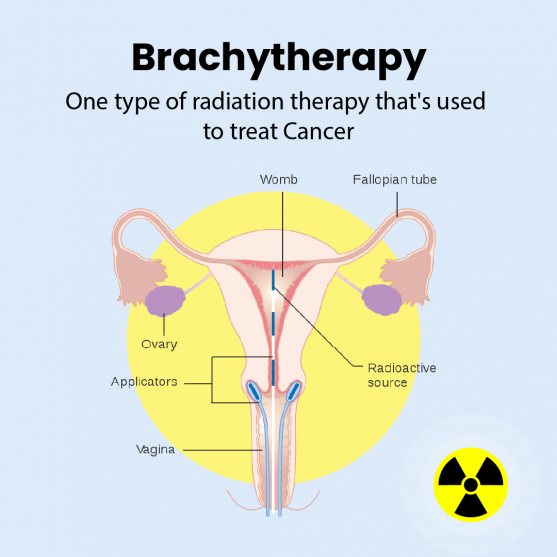Brachytherapy is an integral part of the management of cervical cancer for cases where radiation therapy is the primary treatment.
Cervical cancer is one of the most preventable and treatable types of gynaecological cancers across the world. According to the current data, cervical cancer is the 4th most common cancer among women globally.
The cervix is the lower part of the uterus that connects the vagina (birth canal) and the uterus. Cervical cancer occurs when the normal cells of the cervix undergo mutation (changes) in their DNA and begin to grow out of control.
Over time, the abnormal cells may become invasive cancers that can spread to other parts of the body and at times can be fatal. Most cervical cancers are a result of a previous infection with human papilloma virus (HPV) that has spread during vaginal, anal, or oral sex.
Like most cancer, cervical cancers can be managed effectively when diagnosed early.
What is brachytherapy?
Brachytherapy or internal radiation therapy is a type of radiation therapy in which a device (Catheter/ implants) is placed inside the patient. This device delivers the radioactive materials to the cancer cells near it and destroys them. In this manner, high doses of radiation is provided to precise areas of the body to either kill cancer cells or prevent them from growing.
Brachytherapy is often used to treat cancers of the head and neck, breast, cervix, prostate, eye and and soft tissue sarcomas of extremities.
The type of brachytherapy that is often used to treat cervical cancer is known as intracavitary brachytherapy. Here the radiation source is placed inside the vagina or cervix near the tumor, to deliver a high total dose of radiation in less time.
Why is brachytherapy done?
According to the International Federation of Gynaecology and Obstetrics (FIGO), all women with locally advanced cervical cancer stage IB2-IVA should be considered for brachytherapy as part of their main treatment and management.
For advanced stage cancers, it is performed right after other radiation methods like external radiation therapy, to improve the outcome of the treatment.
Compared to other radiation methods, brachytherapy delivers a curative dose of radiation precisely on the target cells. Therefore, the damage to the surrounding organs such as the rectum, bowel, and bladder is reduced.
What are the different types of brachytherapy?
Depending on the type of cancer and its stage, brachytherapy may be temporary or permanent.
Temporary brachytherapy:
Here the radioactive material which is inserted in the body is removed at the end of each treatment session. The radioactive source is inserted into the cervix using thin plastic tubes (catheters) or cylinders known as applicators.
Temporary brachytherapy is given either at a low-dose rate (LDR) or high-dose rate (HDR).
- Low-dose rate brachytherapy: This method delivers radiation at a continuous low dose of radiation for a few days. The radioactive material is placed in the body by hand or by a machine.
Once the device is in place and the radiation material is inserted, the patient is moved to a shielded hospital room to prevent radiation harm to others.
The patient has to be isolated for a few days to deliver appropriate radiation. After the required time period, the radioactive material is removed from the body.
This type of brachytherapy is now obsolete and not practised.
- High-dose brachytherapy: In high-dose treatment, the radioactive material is inserted for a few minutes and then removed. It usually delivers radiation over 10 to 20 minutes per session.
HDR treatment is usually an outpatient procedure. However, some patients are admitted to the hospital for one to two days depending on the stage of cancer and overall health of the patient.
The radiation source is inserted inside the body under general anaesthesia or moderate sedation. The patient may have to undergo one or two sessions a day over a number of days or weeks.
Once the radiation source is removed, the patient can go home. The whole process typically takes two to three hours.
Permanent brachytherapy:
It involves the implantation of seeds made of radioactive substance next to the tumor and is left there for several months. This implant remains in the patient’s body for the rest of the life, but the amount of radiation diminishes overtime.
What are the risks?
In brachytherapy, the radiations travel for a short distance, and thus the main effects of the radiation is on the cervix and the walls of the vagina.
As the treatment progresses, patients may experience some short-term side effects that begin to appear after initiating the treatment. These include:
- Sore vagina
- Mild vaginal bleeding or discharge
- Irritation of vulva and vagina
- Fatigue
- Diarrhea
- Nausea
- A burning sensation when passing urine (similar to cystitis)
- Deep vein thrombosis (DVT)
However, there are some long-term side effects that may or may not resolve. These effects appear months to years after the treatment.
- Vaginal stenosis (vagina becomes narrower and shorter due to the formation of fibrous tissue)
- Vaginal dryness
- Weakened bones
- Swelling of the leg(s)
- Early menopause and infertility
- Rectal bleeding/rectal stenosis
How to prepare for the procedure?
A pre-surgical testing before the brachytherapy is needed, where the healthcare team would review your medical and surgical history. Certain blood tests and imaging tests would also be performed to help evaluate and finalize the type of anesthesia for the procedure.
Once the therapy is planned, the healthcare team would explain the possible risks and side effects of the procedure. You may receive a set of instructions to help avoid complications during and after the procedure. These instructions include:
- Temporarily discontinue certain medications like aspirin, ibuprofen, etc.
- Stop smoking and drinking as it may prolong the recovery time (this is usually advised even during RT earlier).
- Follow a clear liquid diet starting on the day before your procedure.
- Do not eat or drink after midnight the night before procedure.
What to expect during the procedure?
- Hospitalization may be needed a day before or after the procedure.
- After administration of anaesthesia, the patient is placed in a comfortable position for the procedure. Anaesthesia used for brachytherapy is short term and the vital parameters are monitored.
- A vaginal examination is performed by radiation oncologist to decide the size of the applicators based on the anatomy and disease extent. .
The radioactive material is placed inside the body depending on certain criteria:
- For women who have had a hysterectomy, the radioactive material is placed in the vagina using a tube applicator.
- For women who still have a uterus, the radioactive material is placed in a tandem (a small metal tube) that goes in the uterus, along with ovoid (small round metal/plastic holders) or a round holder (ring) near the cervix, depending upon the extent of the disease.
These applicators are held in place by cotton gauze packed around these applicators placed in the vagina. This gauze packing helps lower the amount of radiation to surrounding organs like rectum and urinary bladder during the treatments & thus decrease the incidence of side effects. Imaging tests are done after the applicator is placed to ensure applicator is in position and also for treatment planning.

Usually, a magnetic resonance imaging (MRI) scan is the preferred imaging test for brachytherapy treatment planning. However in some centres, X ray or CT scan based imaging is also used.
The applicator is then connected to a machine that holds the radiation source, and the planned dose of radiation is delivered.
Outcome of brachytherapy
Once the course of brachytherapy is completed, the healthcare team may recommend scanning tests after 6-8 weeks to determine whether the treatment was successful.
Brachytherapy is one of the most effective cancer treatments as it targets the specific/limited area of interest and has a high success rate. In most cases, the patients who are diagnosed with cancer in the early stage get easily cured with brachytherapy.
For the later stages of cervical cancer, the brachytherapy is combined with the other types of treatments to manage the condition effectively. However, the treatment is more effective when it is completed within a specific period of time and the radiations are delivered in appropriate amounts.


